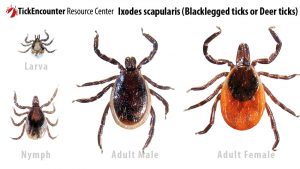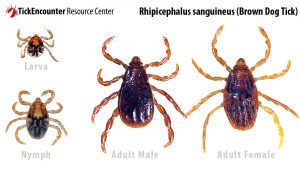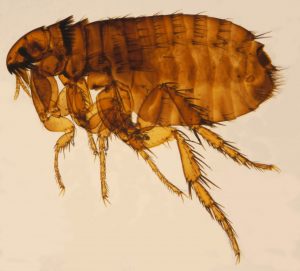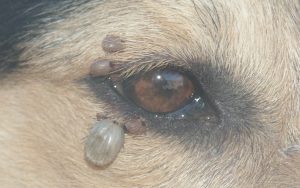 It’s easy to bring fleas and ticks into your home when returning from hikes, walks and outdoor exercise, and far harder to eliminate them.
It’s easy to bring fleas and ticks into your home when returning from hikes, walks and outdoor exercise, and far harder to eliminate them.
Not only are ticks unpleasant and painful, they spread disease and infection through their bites. Fleas are even more common – especially when you have a pet in the house – and can quickly become an out of control infestation.
By following the seven simple tips below you can reduce the number of bugs that make their way into your home, and also learn how to remove them quickly and efficiently.
While there are thirteen different known kinds of ticks in Minnesota, the primary kinds of ticks that you are likely to find are the American dog tick (Dermacentor variabilis), the deer tick / blacklegged tick (Ixodes scapularis), and the brown dog tick (Rhipicephalus sanguineus).

 They are commonly found in longer grasses, in woodlands and on trails, and even the tidiest back yard is not immune to them. Dogs and cats can pick them up while playing outside, irrespective of their breed or coat type, so some kind of tick preventative on your furry friends is important.
They are commonly found in longer grasses, in woodlands and on trails, and even the tidiest back yard is not immune to them. Dogs and cats can pick them up while playing outside, irrespective of their breed or coat type, so some kind of tick preventative on your furry friends is important.
The size and color of the tick can vary, depending on whether or not they are engorged with blood, and on the species, but hatchlings can be as small as under 1mm, while adults can be the size of a sunflower seed, growing to half an inch long if engorged.
There are four phases in a tick’s lifecycle: egg, larval, nymphal and adult. They suck blood during all stages, emitting and transmitting pathogens, living beings that cause illnesses in the host. It is important to identify and remove ticks as soon as possible, as infections can result from a bite, and also transmit Lyme disease and Anaplasmosis in both animals and humans. These are the most common tick-borne diseases in Minnesota, with 1,200-1,400 reported Lyme cases each year, and 600-700 cases of human anaplasmosis being seen.
If you find yourself with a tick invasion in your house, look to repairing any cracks that come inside from the outside, and also keep the area outside tidy and the grass cut.
A more likely source of ticks in the home is pets coming indoors with ticks on them. The ticks may not necessarily be attached, but may be making their way through the fur and can fall off inside as the pet makes its way thr ough the house.
ough the house.
Check your pet before he or she goes back in the house after exercise; problem areas will be armpits, inside of the rear legs, inside ears, bellies and around the eyes. These are all places where the fur is less dense, making it easier for the ticks to attach.
Remove ticks found on people and animals immediately, being careful to remove the head. Clean the area well with antiseptic or alcohol to reduce the risk of infection. Do not crush the body of the tick, but grasp carefully with tweezers around the head, and twist counter-clockwise to remove. To avoid spreading bacteria, it is important not to squeeze the body of the tick. Wash hands thoroughly before and after removal.
There are many other folk remedies touted on the internet for removal of ticks from yourself or your pets, including covering in vaseline, using alcohol, nail polish remover or burning matches, but these are not recommended by the health department and should be avoided for safety.
Should Lyme disease be suspected, often characterized by a red ‘bullseye’ around the wound, retain the removed tick for medical inspection and testing. Symptoms of Lyme disease include severe fatigue, fevers and muscle aches.
Removing ticks promptly is crucial to the prevention of Lyme disease; it is necessary for them to remain attached for 24-48 hours in order to transmit the bacteria. However, there is evidence to suggest that human anaplasmosis is transmitted more quickly; in around 12-24 hours. Symptoms are similar to Lyme, including fevers, headaches, muscle aches and chills and shaking.
In pets, and Lyme is significantly more common in dogs than cats, symptoms include lameness and swollen joints, fever, lymph node enlargement, reduced appetite and lethargy.
Where you are not able to remove the tick safely or if you leave the head embedded, seek medical or veterinary attention.
 Fleas can be found in all areas of Minnesota. Indications include itching and redness of affected areas. For fleas on dogs, veterinarians will be able to prescribe chemicals to kill and repel them, and some can also be purchased over the counter in pet stores.
Fleas can be found in all areas of Minnesota. Indications include itching and redness of affected areas. For fleas on dogs, veterinarians will be able to prescribe chemicals to kill and repel them, and some can also be purchased over the counter in pet stores.
Fleas also carry disease, including plague, cat scratch fever and flea tapeworm. It is very easy for fleas to hide in carpets, rugs and soft furnishings, in areas that don’t get cleaned very often even in the cleanest of houses, and breed indiscriminately.
For more widespread infestations in homes and buildings, it may be necessary to call a pest control company to spray and treat the affected area.
Fleas and ticks are both parasitic in nature, sucking the blood of their hosts and transmitting disease and infection through the bite.
The following advice can make your home less welcoming to fleas and ticks:
- Investigate Your Yard.
The main line of safeguard is shielding your property from bugs and ticks setting up housekeeping anywhere you or your pets frequent.
Keep bushes and trees trimmed back, and the grass cut.
Discourage wildlife and other pets from coming into your yard and bringing pests with them. Keep your pets’ food inside to discourage visitors such as opossums, raccoons and non-domesticated cats.
- Monthly pet treatments – spot on
Use spot on treatments and preventatives on your cats and dogs.
When returning to the home after a walk, brush your pet outside before going indoors to remove any ticks they may have picked up outside, and check the high-risk areas of your pet visually and by feel. The tiny ticks are the hardest to detect, and may not be found with just a cursory glance.
Shearing long haired pets during spring and summer will make it easier to spot any fleas or ticks they may pick up.
- Pet treatments – collars
Flea and tick collars are available in long lasting formulations for both cats and dogs. While a little more expensive than the spot on treatments, they are said to be very effective in preventing bugs from taking up residence on your pet.
- Pet treatments – pills

If you prefer, there are flea and tick treatments for both cats and dogs in pill form. Many also prevent heartworms, so can be a one-stop-shop for a healthier pet.
- Keep Your Home Clean.
Vacuum frequently and in all the corners and under furniture to remove bugs. Change out your vacuum bag or empty the canister frequently – and do it outside – to prevent the bugs from returning to the house and eggs from hatching inside your vacuum cleaner.
Wash pets’ bedding frequently and consider spraying with some kind of flea and tick repellent. If you prefer to stay away from chemical use in your house, there are several kinds of essential oils that are very effective in the fight against fleas and ticks. Once again, be careful when using essential oils around cats as they are extremely sensitive to them.
Lavender, lemon, citronella, bergamot, cedarwood, peppermint, geranium, sweet orange and rosemary are all good for repelling fleas and ticks, and a mild solution can be made up in a spray bottle, mixed with purified water, for use on pet bedding. Alternatively, there are several commercially available herbal based flea and tick sprays and shampoos.
- Use repellant
Both Diatomaceous Earth and Borax are effective repellants; Borax can be toxic to children and animals, however, so should be used with care. When sprinkled around problem areas in the home they can repel and eliminate fleas and ticks.
Using repellent on yourself when outside will also help to prevent fleas and ticks from hitching a ride inside. Products containing DEET or permethrin are excellent repellents, but it’s important to be cautious when using them around animals. Permethrin in particular is highly toxic to cats.
Only use permethrin on your clothing, do not apply directly to skin. Wearing long sleeves and tucking pants into socks can help create a tick barrier.
- Treat infestations promptly.
If you suspect a flea or tick infestation in your house, move quickly to treat with bug bombs followed by extensive vacuuming, or call in an exterminator. An infestation will never resolve itself, and can become out of control in a very short space of time.
Fleas in particular have a long life cycle, and eggs can remain dormant for some time. It may be necessary to have repeat treatments to kill adults and then further treatment after eggs have hatched, so if you choose to tackle the situation yourself, remember to plan for ongoing treatments.
A hands-on approach to both prevention and cure is obviously the best way to handle any kind of bugs, inside or outside of the home. By making your home less inviting to them and removing their opportunities to reproduce, you’re less likely to encounter problems. Repellants and bug bombs are your next line of defense, and you know what they say: an ounce of prevention is worth a pound of cure!
One or two fleas may not seem like a big deal, but remember that fleas are like cockroaches: if you can see a few of them, there’s sure to be millions you can’t see. And when these bugs have the potential to bring illness to hosts, both human and pet, it’s crucial to act immediately. With these seven tips in mind, you’ve got a handle on keeping them out, getting rid of them and making sure your family stays healthy and bug-free.